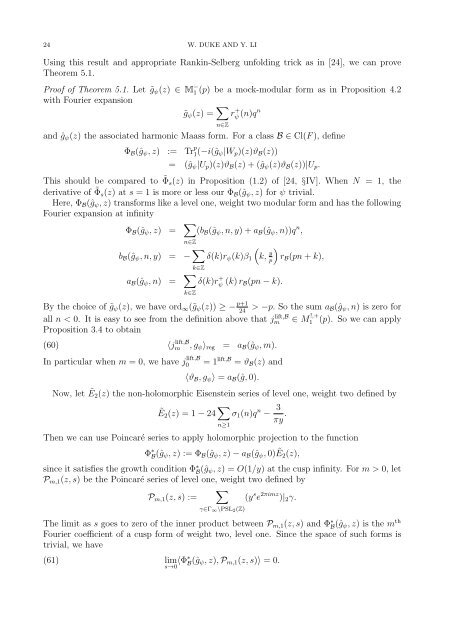Mock-modular forms of weight one - UCLA Department of Mathematics
Mock-modular forms of weight one - UCLA Department of Mathematics
Mock-modular forms of weight one - UCLA Department of Mathematics
Create successful ePaper yourself
Turn your PDF publications into a flip-book with our unique Google optimized e-Paper software.
24 W. DUKE AND Y. LI<br />
Using this result and appropriate Rankin-Selberg unfolding trick as in [24], we can prove<br />
Theorem 5.1.<br />
Pro<strong>of</strong> <strong>of</strong> Theorem 5.1. Let ˜g ψ (z) ∈ M − 1 (p) be a mock-<strong>modular</strong> form as in Proposition 4.2<br />
with Fourier expansion<br />
˜g ψ (z) = ∑ r + ψ (n)qn<br />
n∈Z<br />
and ĝ ψ (z) the associated harmonic Maass form. For a class B ∈ Cl(F ), define<br />
Φ B (ĝ ψ , z) := Tr p 1(−i(ĝ ψ |W p )(z)ϑ B (z))<br />
= (ĝ ψ |U p )(z)ϑ B (z) + (ĝ ψ (z)ϑ B (z))|U p .<br />
This should be compared to ˜Φ s (z) in Proposition (1.2) <strong>of</strong> [24, §IV]. When N = 1, the<br />
derivative <strong>of</strong> ˜Φ s (z) at s = 1 is more or less our Φ B (ĝ ψ , z) for ψ trivial.<br />
Here, Φ B (ĝ ψ , z) trans<strong>forms</strong> like a level <strong>one</strong>, <strong>weight</strong> two <strong>modular</strong> form and has the following<br />
Fourier expansion at infinity<br />
Φ B (ĝ ψ , z) = ∑ n∈Z(b B (ĝ ψ , n, y) + a B (ĝ ψ , n))q n ,<br />
b B (ĝ ψ , n, y) = − ∑ k∈Z<br />
a B (ĝ ψ , n) = ∑ k∈Z<br />
δ(k)r ψ (k)β 1<br />
(k, y p<br />
δ(k)r + ψ (k) r B(pn − k).<br />
)<br />
r B (pn + k),<br />
By the choice <strong>of</strong> ˜g ψ (z), we have ord ∞ (˜g ψ (z)) ≥ − p+1 > −p. So the sum a 24 B(ĝ ψ , n) is zero for<br />
all n < 0. It is easy to see from the definition above that jm lift,B ∈ M !,+<br />
1 (p). So we can apply<br />
Proposition 3.4 to obtain<br />
(60)<br />
〈j lift,B<br />
m , g ψ 〉 reg = a B (ĝ ψ , m).<br />
In particular when m = 0, we have j lift,B<br />
0 = 1 lift,B = ϑ B (z) and<br />
〈ϑ B , g ψ 〉 = a B (ĝ, 0).<br />
Now, let Ẽ2(z) the non-holomorphic Eisenstein series <strong>of</strong> level <strong>one</strong>, <strong>weight</strong> two defined by<br />
Ẽ 2 (z) = 1 − 24 ∑ n≥1<br />
σ 1 (n)q n − 3<br />
πy .<br />
Then we can use Poincaré series to apply holomorphic projection to the function<br />
Φ ∗ B(ĝ ψ , z) := Φ B (ĝ ψ , z) − a B (ĝ ψ , 0)Ẽ2(z),<br />
since it satisfies the growth condition Φ ∗ B (ĝ ψ, z) = O(1/y) at the cusp infinity. For m > 0, let<br />
P m,1 (z, s) be the Poincaré series <strong>of</strong> level <strong>one</strong>, <strong>weight</strong> two defined by<br />
∑<br />
P m,1 (z, s) :=<br />
(y s e 2πimz )| 2 γ.<br />
γ∈Γ ∞\PSL 2 (Z)<br />
The limit as s goes to zero <strong>of</strong> the inner product between P m,1 (z, s) and Φ ∗ B (ĝ ψ, z) is the m th<br />
Fourier coefficient <strong>of</strong> a cusp form <strong>of</strong> <strong>weight</strong> two, level <strong>one</strong>. Since the space <strong>of</strong> such <strong>forms</strong> is<br />
trivial, we have<br />
(61) lim<br />
s→0<br />
〈Φ ∗ B(ĝ ψ , z), P m,1 (z, s)〉 = 0.
















